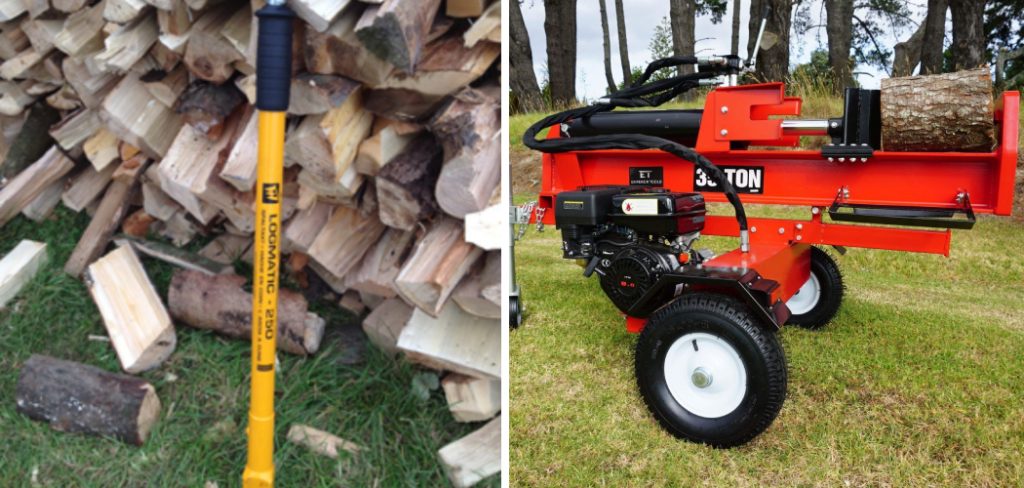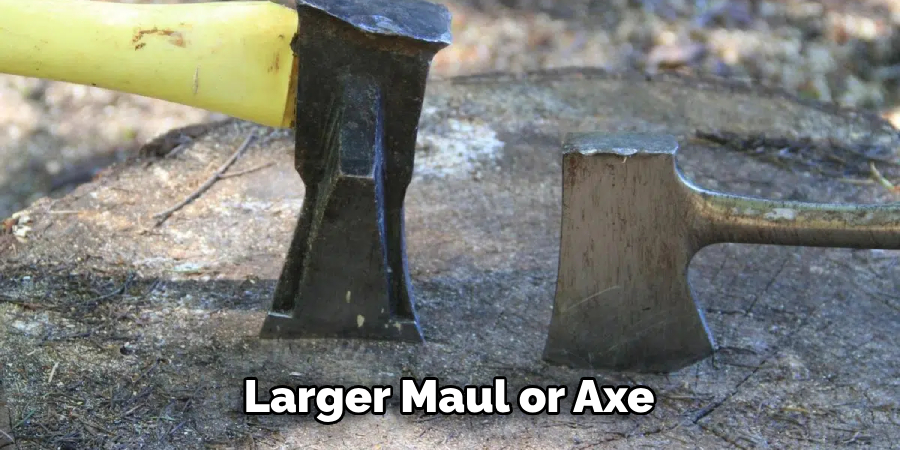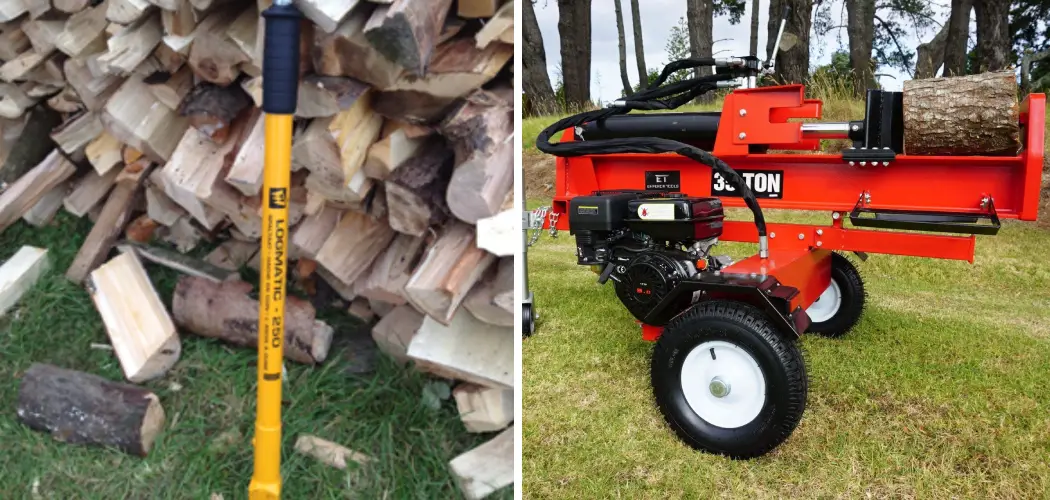Are you looking for a way to split logs or large wood chunks without using expensive log splitting machines? Look no further! Splitting wood by hand can be a great way to save time and money while still getting the same results.

If you’re looking to split wood without a log splitter, here are some tips and tricks to get how to split logs without a log splitter.
In this blog post, we’ll show you how to use simple tools and techniques to successfully split even tough logs so they are ready for firewood or other outdoor projects.
Whether you’re just getting started with splitting logs or need tips on perfecting your technique, these easy-to-follow instructions will get you going quickly. So grab your axe, maul, wedge, hatchet — whatever tool works best for you — and let’s get cracking!
Why Do People Split Logs?
Splitting logs is a great way to reduce the size of large pieces of wood so that they can be used for firewood, kindling, or even outdoor projects like furniture. Splitting logs also helps ensure the wood will burn properly and easily in your fireplace or stove.
Logs can be split in many ways, but using a log splitter is often the fastest and most efficient. However, if you don’t have access to a log splitter or don’t want to invest in one just yet, here are some tips for splitting logs without a log splitter.
What Will You Need?
- Axe or Maul: Depending on the size of logs you’re splitting, and how tough they are, you may need a larger maul or axe to get the job done. Make sure it is sharp and ready for use!
- Wedges: Wedges can help to make log splitting much easier, as they act as an extra set of hands, pushing the logs apart as you hit them with your maul.
- Block of Wood: You’ll need a block of wood to place the log onto when splitting it so that it is secure and won’t move while you hit it.
- Safety Gear: As always, safety comes first! Wear protective gear such as gloves, safety glasses, and a dust mask when splitting logs.

10 Easy Steps on How to Split Logs Without a Log Splitter
Step 1: Prep Your Workspace
First things first, prepare your workspace. Choose an open area that’s free of obstacles and distractions where you can safely swing your axe or maul. The ground should be flat and sturdy, with enough space to maneuver around the log. You should also have enough room to safely swing your splitting tool without hitting anything. Ensure your block of wood is stable on this ground to avoid unnecessary accidents.
Step 2: Position the Log
Now that your workspace is ready, it’s time to position the log you’ll be splitting. Set your log upright on the block of wood you’ve prepared. The log should be balanced and stable before you start splitting. For larger logs, it can be beneficial to start on the outer edges, working your way inward. This approach is easier than trying to split the log down the middle right from the start.
Step 3: Aim and Strike
With your workspace ready and the log in position, you’re all set to make your first strike. This crucial step determines how smoothly the rest of the process will go. Make sure to aim for the center of the log if it’s small to medium-sized. As mentioned before, starting from the outer edges is more effective for larger logs.
Hold your axe or maul with both hands, maintaining a firm grip, and swing it toward the part of the log you’re aiming at. Ensure your swing is forceful but controlled — don’t sacrifice accuracy for power. The goal is to strike accurately and create a crack or seam along which the log will split.

Step 4: Drive in the Wedge
If the log has not split after your first strike, it’s time to introduce a wedge. Place the wedge into the crack or seam you’ve created with your initial strike. Ensure the wedge is secure and stable, then use your maul or another hammering tool to drive the wedge into the log.
The purpose of the wedge is to widen the initial crack, forcing the log to split along the grain. Proceed with caution, ensuring that the wedge doesn’t slip or bounce back during this process.
Step 5: Split the Log
Once the wedge is firmly embedded, continue hitting it with your maul or hammer. Each strike should be forceful but controlled, driving the wedge deeper into the log. As you do this, you’ll see the log splitting along the grain.
This process may take a few hits, especially for larger or more stubborn logs. Don’t be discouraged; persistence is key. Once the log has split into two pieces, you can repeat the process with the halves if they are too large for your needs.
Step 6: Clean Up and Store the Wood
After successfully splitting the log, cleaning up your workspace and properly storing the split wood is essential. Gather all the split pieces and stack them in a dry, cool area where they can properly cure. Curing is drying out the wood, making it appropriate for burning. This process can take anywhere from 6 months to a year, depending on the type of wood and the conditions in which it’s being stored.

Step 7: Safety Considerations
Safety should be your top priority when splitting logs manually. Always use protective gear such as gloves to prevent blisters, safety glasses to protect your eyes from flying debris, and sturdy footwear to protect your feet. Remember never to use dull tools as they can slip and cause accidents. Always make sure your tools are sharp and in good working condition.
Step 8: Sharpen Your Tools
Maintaining the sharpness of your tools is crucial for efficient log splitting. Dull tools make the process more difficult and time-consuming and increase the risk of accidents as they’re more likely to slip or bounce off the wood. Regularly check the sharpness of your axe, maul, and wedges and sharpen them as necessary. You can use a file or a sharpening stone for this purpose.
Step 9: Log Maintenance
Slippery and wet logs can be hard to split, so make sure to clean them before beginning the splitting process. This step is crucial if you’re planning on keeping the log halves for firewood. Use soap and water or a pressure washer to remove any dirt and debris from the surface of your log. Make sure that it’s scorched before beginning the splitting process.
Step 10: Have Fun!
Splitting logs by hand can be a fun and rewarding experience when done safely and efficiently. It allows you to get some fresh air, enjoy nature, and build strength as well. So take your time, stay safe, and have fun!

By following these simple steps, you’ll be able to split logs without a log splitter in no time. With practice and dedication, you’ll soon become an expert!
5 Additional Tips and Tricks
- Store the logs in a cool, dry area so your logs will be easier to split. If the log is damp or wet, splitting may take more effort and time.
- Make sure you wear protective gear while splitting firewood, as pieces of wood can fly across the room with lots of force. Safety goggles, work gloves, and steel-toed boots are important items to wear while splitting logs.
- Use a cutting board or an old sheet of plywood to catch any pieces of wood that might fly away from the split log. This will help contain flying debris and minimize messes in your workspace.
- When using a maul, always keep the handle pointed away from you when striking the log. Otherwise, it could cause serious injury.
- If the log is too large or dense for you to manage on your own, enlist the help of a friend or family member who can assist with splitting logs safely and efficiently. Having someone else to hold down the log can make all the difference regarding safety and efficiency.
As you can see, many different ways to split logs without a log splitter exist. Whether you are using an axe or maul, it is important to remember that safety should always be your top priority. With the right tools and techniques, you can get your firewood ready for burning quickly!

5 Things You Should Avoid
- Avoid Splitting on Uneven Ground: Always split logs on a flat, sturdy surface. Splitting on uneven ground can cause the log to roll or the axe to deflect, potentially leading to accidents.
- Avoid Using a Dull Blade: A dull blade will make the task more difficult and increase the risk of the axe glancing off the log.
- Avoid Overexerting Yourself: Log splitting is physically demanding work. Don’t overdo it — take regular breaks to rest and rehydrate.
- Avoid Ignoring Safety Measures: Never overlook the importance of protective gear, even if the task appears simple.
- Avoid Splitting Alone If Possible: If you are splitting a large or challenging log, it’s wise to have someone else around for support or in an emergency.
Avoiding these mistakes will help ensure your log splitting experience is safe and successful. With the right tools and techniques, you can easily split logs without a log splitter!
How Do You Split Logs Without an Axe?
Splitting logs without an axe is entirely possible. In fact, several alternative tools and methods allow you to split logs with ease.
- Maul: A maul is similar to an axe but has a broader head and is heavier. It’s designed to split logs along the grain rather than chop through them, making it an effective tool for splitting logs.
- Wedges and Sledgehammer: This method involves using a metal wedge and a sledgehammer. Start by placing the wedge at the center of the log, then hit the wedge with the sledgehammer. After several hits, the log should start to split.
- Manual Log Splitter: While slower and more powerful than a hydraulic log splitter, a manual log splitter is more affordable and portable. These tools use mechanical leverage to split logs, and while they require some effort, they’re significantly easier than splitting logs with an axe or maul.

Remember, safety should always be your top priority, regardless of your chosen method. Always wear protective gear, work safely, and follow the appropriate precautions to prevent accidents.
Conclusion
Splitting your logs without a splitter doesn’t have to be dull or laborious. You could change the way you approach each log-splitting session with an array of your favorite tools. Remember, it’s important to wear protective gear when attempting the methods in this blog post to keep yourself safe and protect the valuable tools that have been so helpful.
And since most of these solutions take advantage of leverage, it should be a relatively simple task for anyone who works at home – or wants to feel like they do – from DIY experts and seasoned carpenters alike! With some practice and smart technique, logging by hand may become enjoyable as you work and appreciate nature’s gifts.
Hopefully, the article on how to split logs without a log splitter has been useful in helping you understand the many methods available to do so. Whether using an axe, maul or splitting wedge, use the proper tools and techniques when splitting logs to ensure your safety and success!

